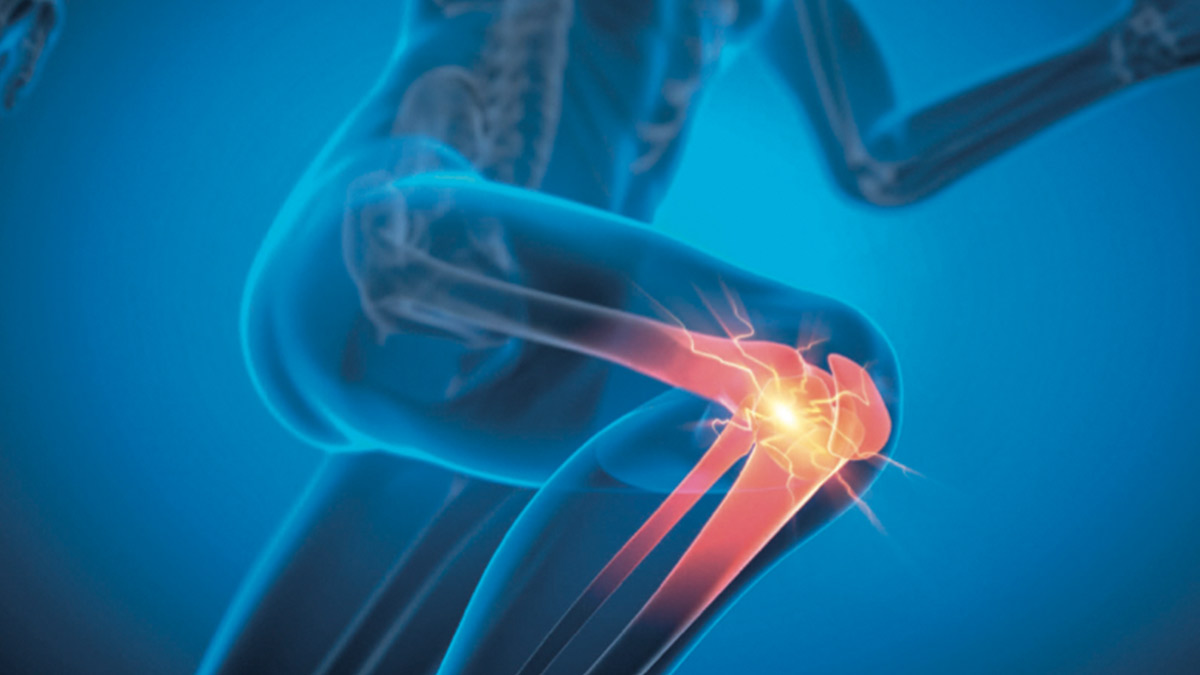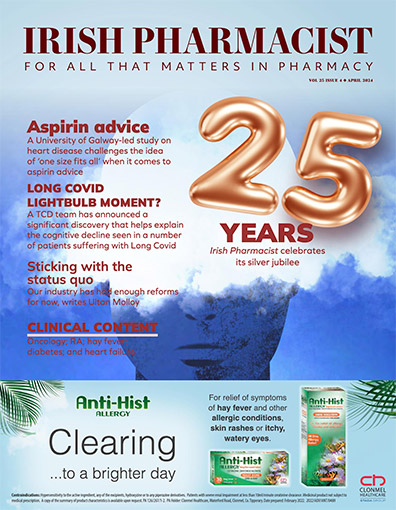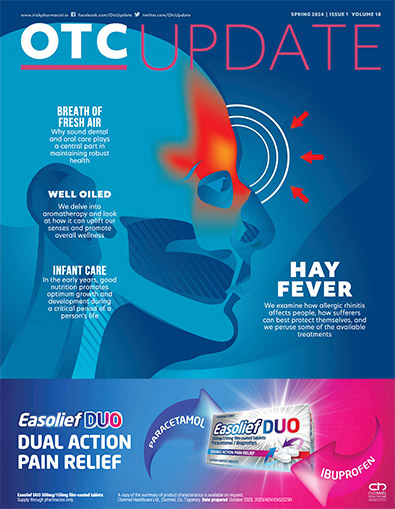Dr Donna Cosgrove PhD MPSI provides a clinical synopsis of Crohn’s disease and ulcerative colitis
Inflammatory bowel disease: Incidence and pathology
The inflammatory bowel diseases (IBD), Crohn’s disease (CD) and ulcerative colitis (UC), are chronic idiopathic disorders that cause inflammation of the gastrointestinal tract (GIT). In some cases, distinguishing CD from UC can be challenging if inflammation is confined to the colon. In Europe, over two million people suffer from the disease.1 During the 20th Century, IBD was mainly a disease of Westernised countries, but more recently the incidence has accelerated in Asia, South America, and Africa, where societies have become more Westernised.
The pathogenesis of CD and UC is multifactorial: It involves a dysregulated immune response to GIT microbiota in genetically-susceptible individuals. More than 200 genetic risk variants for IBD have been identified.2 These indicate genes involved in the innate immune response, adaptive immunity, autophagy, endoplasmic reticulum stress, intestinal epithelial barrier function, and microbial defence pathways. Approximately 70 per cent of these risk loci are shared with other immune-mediated disorders, ie, type 1 diabetes mellitus, coeliac disease, rheumatoid arthritis, ankylosing spondylitis, and psoriasis.
Although genetic studies have increased our understanding of IBD pathogenesis, it is still unclear why many individuals who carry IBD-associated genetic risk variants remain healthy, while others develop IBD. The increasing incidence of IBD in newly-industrialised countries indicates the involvement of a Western lifestyle, urbanisation, and industrialisation.
Observations have highlighted a number of environmental risk factors for IBD, including cigarette smoking (protects against UC, increases risk for CD in Western, but not in Eastern Asian countries); antibiotic use during childhood (increases risk in Western countries, reduces risk in Eastern Asian countries and among immigrants from the Middle East); breastfeeding (protects against IBD); oral contraceptives (increases risk for CD); appendectomy (protects against UC); low levels of vitamin D (increases risk for CD); and consumption of tea or coffee (reduces risk for CD and UC among Asians).
Increasing our understanding of genetic, environmental, and microbial interactions is still required to provide insight into why only some people with high-risk genetics, or persons with specific risk factors, develop IBD. The hygiene hypothesis, proposed by Strachan in the 19th Century, presents an explanation for the increasing incidence of autoimmune/allergic diseases in industrialised nations.2 Factors associated with lower risk of CD and UC include having pets in childhood, living on a farm, having a larger family, and drinking unpasteurised milk.
Chronic inflammation in patients with colonic involvement in UC and CD is believed to be the cause of an increased risk of colorectal cancer.4 Patients with active disease are more likely to have comorbid psychological conditions of anxiety and depression, and even impaired social interactions or career progression.3
Crohn’s disease
Typical symptoms of CD include abdominal pain and diarrhoea, while fatigue, weight loss, fever, growth failure, anaemia, recurrent fistulas, and extraintestinal manifestations can also present.4 The most common symptom is chronic diarrhoea, but not all patients experience this. Abdominal pain, particularly in the right lower quadrant of the abdomen, is common, worsening postprandially.
Fatigue potentially arises from a number of factors: Inflammation, anaemia, or various vitamin and mineral deficiencies. Some patients present with fever, weight loss or stunted growth. The disease is diagnosed clinically because there are no truly specific features; however, endoscopic, radiographic, and histologic investigations can provide evidence of chronic intestinal inflammation. In general, it is this presence of chronic intestinal inflammation that solidifies a diagnosis of CD. Extraintestinal manifestations of CD include arthropathy, dermatological, ocular, and hepatobiliary disease, and less commonly, thromboembolic, metabolic bone diseases, osteonecrosis, cholelithiasis, and nephrolithiasis. A number of immune-mediated diseases are associated with CD (asthma, psoriasis, rheumatoid arthritis, and multiple sclerosis). CD is a chronic, progressive, destructive disease: The chronic inflammation can lead to complications such as strictures, fistulas, and abscesses. The location of CD tends to be defined, although it can occasionally extend, however this occurs only in about 6-to-14 per cent of patients. Patients with ileal, ileocolonic or proximal GIT involvement are more likely than those with isolated colonic disease to progress to an intestinal complication. Over long periods, up to 30 per cent of patients with CD will have a non-progressive course; however, most patients will require active effort to identify therapies that achieve adequate control of bowel inflammation. Because symptoms of CD do not correlate well with the presence of active inflammation, they should not be the sole guide for therapy. Objective evaluation, ie, by endoscopic means, should be undertaken periodically.
Clinical disease activity in CD is can be in remission, mild, moderate, or severe.4 Determination of disease activity is based on clinical measures, impact on quality of life, complications of disease, and complications of therapy. Mild disease is when patients are ambulatory and are eating and drinking normally, with <10 per cent weight loss and no complications such as obstruction, fever, abdominal mass, or dehydration. These patients may have diarrhoea and abdominal pain and elevated serum C-reactive protein (CRP). Patients with severe disease may be cachectic, with significant weight loss, and present with complications such as obstruction or intra-abdominal abscess. Symptoms persist despite aggressive therapy.
Ulcerative colitis
UC is a chronic, immune-mediated inflammatory condition of the large intestine, frequently associated with inflammation of the rectum and often extending to areas of the colon.3 The initial symptoms include abdominal cramping, passing mucous/blood, urgency, and tenesmus (a sense of pressure). The condition may present at any time and at all ages, but the most common age of onset is between ages 15 and 30 years.
UC is a relapsing and remitting disease, although some patients with UC have persistent disease. A full clinical history should include assessment of disease severity, precipitating triggers, and potential alternative aetiologies. Assessment of bleeding should include the proportion of bowel movements that are mixed with blood. Other important symptoms to assess include urgency, abdominal pain, and weight loss, which is a marker of severity of disease. A thorough history should assess the presence of extraintestinal symptoms, including joint, skin, ocular and oral manifestations, and symptoms suggesting hepatobiliary involvement. Potential precipitants of UC may include recent smoking cessation, non-steroidal anti-inflammatory drug (NSAID) use, and enteric infections. C.diff infection is associated with complications in UC and is associated with an increased risk of hospitalisations, surgery, and even mortality.
It is important to determine the extent and severity of the disease in order to select the appropriate treatment — diagnosis requires a lower GIT endoscopic examination with histologic confirmation. Severe disease can include bowel frequency greater than six times a day in conjunction with fever, tachycardia, anaemia, or an elevation in ESR (erythrocyte sedimentation rate). Non-adherence to therapy is common in patients with UC (40 per cent), which increases risk of relapse and cost of management. UC is an evolving disease, and there is a risk of disease extension even in individuals with initially localised disease.3 Symptoms alone should not be used as the only measure of remission and patients need to be aware of this, as symptomatic remission can lag behind healing. Therapeutic management in UC should be guided by the specific diagnosis, assessment of disease activity (ie, mild, moderate, or severe) and disease prognosis.
Treatment of IBD
The goals of therapy in IBD have historically been based on symptomatic response, with good control of symptoms and improved quality of life.4 Treatment recommendations are based on disease location, severity, complications, and future prognosis, with medical treatment usually divided into induction and maintenance therapy.
The specific anatomical distribution of disease is important for medications with targeted delivery systems. For other agents, therapeutic activity is believed to occur throughout the entire GIT. These phases of treatment involve achieving control of inflammation and then maintaining that control. IBD medication includes 5-aminosalicylates (5-ASA), antibiotics, corticosteroids, immunomodulators, and biologics. Treating milder disease should ideally be balanced between clinical efficacy, risk of adverse effects, and cost. Agents proven to be effective in moderate-to-severe disease (ie, anti-TNF agents) are effective in mild disease as well, even though such patients have not been explicitly studied in certain RCTs. On the other hand, the risk of adverse effects and high cost of such agents may not be justifiable in milder disease. Unfortunately, few agents investigated for use in milder disease populations have been proven to be effective. It has been suggested that the aim to avoid over-treating disease and exposing patients with mild symptoms to unnecessary risk has led to the use of medications that are not justified by clinical evidence, ie, 5-ASAs are widely prescribed for the treatment of CD, despite evidence showing a lack of efficacy.
Mesalamine
5-ASA acts as a topical anti-inflammatory agent with well-established, evidence-based use in UC.4 A meta-analysis of 11 randomised controlled trials (RCTs) of patients with UC treated with 5-ASA for induction or maintenance demonstrated superiority of 5-ASAs in inducing remission compared with placebo.3
Oral mesalamine has not been shown to be consistently effective compared with placebo patients with active CD. Sulfasalazine is a combination of 5-ASA, responsible for the anti-inflammatory property of this drug, and sulfapyridine, which is the carrier that allows 5-ASA to be delivered into the colon.4 It is effective for mild-to-moderately active colonic CD and/or ileocolonic CD, but not in isolated small bowel disease.
For rectal/sigmoid disease, 5-ASA suppository and enema preparations are effective for induction and maintenance. The role of topical mesalamine in CD, although commonly used, is of limited benefit. Sulfasalazine is often limited by intolerance (headache and nausea), allergy to the sulfa moiety, and need for multiple daily doses.3
Corticosteroids
Corticosteroids are used primarily for the treatment of IBD flare-ups.4 They reduce symptoms and induce remission in active CD and UC. In UC, oral corticosteroids can be used to induce remission in moderately-to-severely active disease or when oral 5-ASA therapy has failed. Budesonide is a locally-acting corticosteroid with high first-pass metabolism and minimal systemic side-effects.3 Although not as effective as conventional oral corticosteroids, controlled-release budesonide was found to be superior in achieving clinical relief compared with 5-ASA and placebo, and may be effective for short-term relief of symptoms of mild-to-moderate CD.
Immunomodulators
Thiopurine agents and methotrexate are not effective agents for short-term induction in active, symptomatic disease because of their relatively slow onset of action (eight-to-12 weeks). In patients with moderate-to-severe IBD who remain symptomatic despite current or prior corticosteroid therapy, the thiopurine analogues (6-mercaptopurine and azathioprine) can be used.4 Methotrexate (SC or IM) and thiopurines are also effective as steroid-sparing agents.
Anti-TNF agents
The anti-TNF antibodies (ie, infliximab, adalimumab) are effective for treatment of patients with IBD who do not respond adequately to corticosteroids, thiopurines, or methotrexate.4 In CD, studies suggest that combination therapy of infliximab with immunomodulators is more effective than either agent given alone in patients with no prior exposure to either treatment.
Biosimilar infliximab/adalimumab are effective treatments for patients with moderate-to-severe IBD and can be used for induction and maintenance therapy. Up to 20 per cent of patients using anti-TNF agents may not respond, and an additional 10-to-15 per cent may lose response each year despite an initial response.3
Agents targeting leukocyte trafficking
The anti-integrin drug vedolizumab is an effective therapy for induction of remission of moderately-to-severely active UC and CD.3 It selectively inhibits ?4?7 integrin interaction with mucosal addressin cell adhesion molecule-1, making it relatively specific for leukocyte trafficking to the gut.4 It has been used in adult patients with moderately-to-severely active CD who have not had an adequate response/lost response to/were intolerant to a TNF blocker or immunomodulator, or those who have demonstrated dependence on corticosteroids.
Janus kinase-1 inhibitors
Tofacitinib is an orally-administered, non-selective inhibitor of the Janus kinase enzyme, approved for the treatment of moderate-to-severe UC.3
Agents targeting IL-12/23 (anti-p40 antibody)
Ustekinumab inhibits IL-12 and IL-23, leading to inhibition of inflammatory pathways.4 It is used in patients with CD and UC whose prior treatments have included corticosteroids, immunomodulators, or anti-TNF agents.
Novel agents
Despite the recent advances in the treatment of IBD, there is still a substantial subset of patients who do not respond adequately.4 Many novel agents are in various phases of development. Some anti-integrins (etrolizumab or ozanimod), anti-IL-23 agents (risankizumab and brazikumab), and selective Janus kinase-1 inhibitors (filgotinib and upadacitinib) are under investigation.
For patients with IBD, realistic expectations for treatment are important, ie, managing symptoms as opposed to curing the conditions, as well as an understanding of the importance of treatment adherence to improve prognosis.







